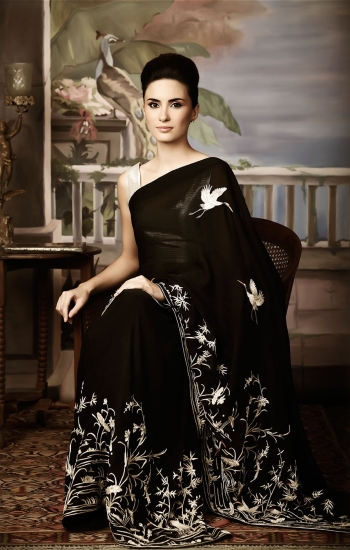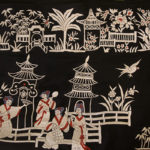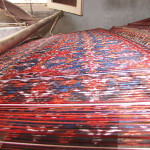Of Parsis and Pagodas
Of all the sartorial blunders that I admittedly made on my wedding day, there is one that haunts me to this moment. My mother, hoping to make my most important life’s event a true happening, escorted me to the Mumbai home of the erstwhile gara sari revivalist, Naju Daver of Naju Daver Creations and suggested a silk sari in palest ivory encircled with roses, butterflies, stalks and leaves in a myriad pastel hues, all delicately hand embroidered in the wonderful gara tradition of fine stitches. And what did I do, in the stupidity of youth? I turned my face away, to a plebian length of silver lace, bridal to be certain but no heirloom as the wedding gara would have been. Will I, with pride, pass my lace down through the generations? No. But I would have the gara that never was. Even though it may not have been an ‘original’ gara – those, of course, are priceless today.
Former model Mehr Jesia it would seem had far better sartorial sense when she turned Rampal in a superb fully-embroidered white gara with a pearl and diamond choker encircling her swan-neck. A Naju Daver creation that was photographed endlessly and aired in publications that fully endorsed her bridal choice. Being a part of the Parsi community, as I am, this seemed like an organic selection, stemming from the history of the gara as it is interwoven with the history of the Parsis – Zoroastrians who came to India 1200 years ago from Persia. The gara became a part of family heirlooms and Parsi women forever discovered their place in the country’s fashion archives with their intricately-embellished choices.
The history of the gara is irrevocably tied up with the history of China’s opium trade with India. When the Sassoons and the Jeejeebhoys, wealthy Jewish and Parsi traders in the 19th century started trading in opium and yarn with China, the gara was born – six metres of Chinese hand-woven silk (called gaaj or paaj) from China with traditional Chinese embroidery on the border and pallav or on the entire body of the sari. Some Chinese garas even had the name of the lead embroiderer embroidered in Chinese characters, making them in effect signed works of art.
Now here’s something really interesting that I discovered in my conversation with fashion designer Ashdeen Lilaowala known for his contemporary gara creations as well as western wear embellished with gara embroidery. Lilaowala tells me that as a student at NID he started research with the UNESCO Parzor Project. He later became consultant to its textile module, dedicated to making people understand that “the gara is a treasure not to be lost”. The young designer travelled on behalf of Parzor across India, China and Iran, “tracing roots and routes” and discovering a definite connect with trade with China. The interesting part? “Research showed that there was a lot of interaction between Parsi men and women and the Chinese craftsmen and through this interaction was created a totally new art form,” he reiterates. Thus, this was more than a mere buyer-seller relationship. China was already exporting textiles for the European market but Parsi ladies, as always, decided to have their say. “In later years, designs were actually developed in India by these ladies who even travelled to China to get them executed,” he says.
Shernaz Cama, Director, Unesco Parzor Project, is passionate about textiles and therefore about ‘Parsi embroidery’. Her researchwas piqued by her search for the symbolism in gara embroidery, particularly the Chinese form, ‘the divine fungus’ and other symbols of protection. “The oldest garas,” she says, “were just satin yardage from China.” No more than fabric, basically. “It is important for women who own garas or who hope to own garas to realise that while we talk about globalisation today, the gara is the first real hybrid multi-cultural embroidered textile. From Iran comes the Iranian love of nature as seen most of all in the gul-e-bulbul design and the recreation of the Persian Paradise. From China, the finesse of Chinese embroidery as seen especially in the satin stitch. From India come motifs like the lotus, the Swastika, as well as traditional Indian pallavs and borders. From Europe has come the colour palette, scalloped edges and designs like bows and baskets.” She concludes with suitable drama, “Therefore, every Parsi gara is a multicultural amalgam and belongs to the heritage of humanity.”
The Parsi community dazzled in garas that emblazoned motifs that included birds, flowers, pagodas and even Chinese figures. At first, the entire sari was framed on all four sides by a border embroidered directly onto the silk but later, the part that was tucked in at the waist remained unembroidered and while wearing it Gujarati style, the end of the portion draped over the shoulder on the pallav was also left unembellished. Later, a separate border strip with intricate embroidery that can be sown onto the sari was introduced, called a kor. Today’s fashionistas are often intent on discovering intact old kors as the ultimate vintage fashion find and the lucky may still make some amazing discoveries in the secondhand sari shops off Mumbai’s Grant Road. (Now here’s a story – India’s ace fashion designer, Tarun Tahiliani once mentioned to me that when he was starting out, he laid his hands on a batch of gara borders and cut them up to embellish his outfits – something he has regretted ever since.)
Garas at one time formed a regular part of a bride’s trousseau and were often worn with Cartier jewellery or strings of pearls that highlighted the white embroidery. At one time, Parsi women wore eejaars or ‘pantaloons’ under the saris rather than petticoats. A brooch or jewelled pin attached the top of the pallav to the blouse at the front of the right shoulder. The pallav worn over the head, leaving the left ear exposed, gave rise to the fashion statement of the single earring, the bane of those who inherited these individual pieces! The highly fashionable wore embroidered shoes that matched their garas perfectly.
The Chinese fabric was originally woven on narrow looms, and gara saris were made up of two separate pieces stitched together to make the required width. These saris were called dor-pat or do-patti. These original silks were dyed with vegetable colours that would run if the fabric was washed. Garas were only ever aired and, in very extreme cases, dry-cleaned. These original garas camemainly in shades of purple, violet, indigo, magenta, navy blue and dark blue. The work was so fine that it was often difficult to tell the wrong side from the right. The silk, cotton and sometimes gold threads were in such subtly-matched colours that sometimes a pattern used up to 20 to 30 shades. Each gara was unique and could never be replicated. Gara embroidery further embellished the wardrobes of Parsi ladies in the form of jhablas or tunics and badans or bodices. These may be seen today carefully framed in Parsi homes, probably in order to preserve them for generations to come.
In the later years, Chinese vendors on bicycles called pherias or ferias in the 1920s and 1930s brought much-coveted saris to Parsi women in India. They were all called ‘Johns’ and the ladies would sit with them on their porches and there was much interaction between them. There are also stories of Chineseembroiderers working for the Parsis in India. Parsi women learnt embroidery techniques from them but “this was on a very amateur level, only for themselves and never done commercially,” says Lilaowala. (In his Mumbai home, a piece of gara embroidery created by his grandmother hangs framed on the wall, in place of pride, perhaps a piece of early inspiration?) The dragons and snakes of Chinese design were replaced by roosters and fish and other symbols more familiar to Zoroastrian tradition. “The basic love of nature which is a Zoroastrian love of nature has been there from time immemorial and is reflected in gara designs,” says Cama. By now, silk weaving for the gara was done in China as well as in India so that “the fluid gara was an Indo-Chinese cooperation. The surti gaj woven in Gujarat was in fact one of the best gara fabrics,” adds Cama.
The gara’s popularity went through a period of 100 years from around the 1830s to the 1920s but with the Chinese political upheavals of the 20th century the trade stopped and with it the further spread of the gara. The early and mid-20th century saw a fall in demand and there are horror stories of these exquisite saris being cut up to make housecoats. “The war in China, communism, the hampering of the Parsi trade which was taken over by other Indian communities, the National Movement in India which saw people wearing khadi were some of the reasons that stopped the flow of the saris,” says Lilaowala. Georgettes and crepes came into fashion and in the ’60s and ’70s the craze for nylons and polys took over.
And yet, many continued to preserve the garas, often stored in the traditional way in intricately-carved camphor chests (some originally from China), with peppercorns and sandalwood stick to keep away moths and insects, tied in a corner of the muslin cloth in which the sari was wrapped and placed flat – never hung! “Remember!” says Lilaowala, “that the gara was never a cheap commodity. It was always considered expensive and so some people continued to treasure it.”
Today’s revival was wrought many years ago when Naju Daver sought to recreate the intricate embroidery in exquisite new pieces. Says her daughter Farzeen Daver-Boomla who has continued in her mother’s tradition, “Our great grandmothers and grandmothers did possess garas and passed them down to a lucky few but most people never valued them and traded them for pots and pans from the jaripuranawala till one day when Mom tried to salvage an old gara and brought awareness in our community to preserve them and not cut them up into cushions or curtains. She was the sole person to revive this art and bring appreciation to beautiful embroideries 30 years ago. Mehr was her first model when she was Miss India in 1986.” She adds that a gara can today take anything from six to eight months to create while full garas with intricate work can take up to a year. “We mostly work with satin stitch and chain stitch and occasionally do the French knots, known as the ‘forbidden stitch’. Mehr’s sari is entirely made with French knots. We have never compromised on our work and can proudly say that the work is as neat from the back as the front,” she adds.
Daver’s revivals have rarely been emulated in their intricacy for though she commercialised the gara, she truly loved this art form and spent a good deal of her time restoring old garas by transferring the embroidery from damaged saris to new base materials. I recall some wonderful afternoons spent with mother and daughter surrounded by inspired embroideries as family members, young and older, acquired their new garas – a beautiful deep blue embellished with pink flowers for a cousin, a fabulous maroon with ivory chrysanthemum border for a niece and subtly pale creations for several aunts.
In modern times, gara embroidery has found itself on western garments as well. “I have made stoles and shawls for an international clientele as they don’t wear saris,” says Farzeen. Rati Godrej, the petit wife of Nadir Godrej may be spotted at a classical music event in an exquisite gara-embroidered skirt suit or long coat. The ramp at Fashion Week this year threw up delicious designs by Lilaowala who has made the gara contemporary and younger by reworking elements from the embroidery. A crane or butterfly motif may unusually cover the entire sari. Elements of the traditional embroidery have also been incorporated in garments by designers like Sabyasachi and Anamika Khanna, the former occasionally combining the Parsi border with gota patti. “They have their own repertoire in which they incorporate gara embroidery,” says Lilaowala.
Having messed up on my wedding sari, I now look forward to a wedding in the family, someone close enough to warrant the acquiring of a priceless sari. And of course, this time around, I will pass it down to future generations with pride.
Care for your gara….
Shernaz Cama, Director, Unesco Parzor Project, who has researched ‘Parsi embroidery’ in depth says, “If you have a gara, please preserve it carefully….”
• Do not wrap it in plastic since the silk needs to breathe.
• Store flat in cotton/mulmul sari bags.
• To prevent staining, add dried tobacco leaves wrapped in muslin to the sari bag.
Related posts from Verve:
Verve Trending
Sorry. No data so far.
us on Facebook to stay updated with the latest trends







